“A team of scientists have said that their extraordinary discovery of 14 news species of dancing frogs in the Indian jungle is “both joyful and sad”, as it is likely they will soon all become extinct. Biologists have been studying the animals, named because of the unusual kicking displays they use to attract mates, for more than a decade in the jungle mountains of southern India. Their study formally identifying the new species, published today in the Ceylon Journal of Science, more than doubles the number of known Indian dancing frog species to 24.
The frogs are found exclusively in the Western Ghats mountain range, but that habitat is rapidly shifting as a result of climate change. The frogs are tiny and delicate, around the size of a walnut, so are only able to breed in a delicate window between monsoon storms that would wash them away and the point when streams dry up altogether. Even in just the brief period that they have been analysed for the first time by scientists, numbers have dropped to around a fifth of what they were in 2006.
The tiny amphibious acrobats appear similar to others in Central America and Southeast Asia, but the Indian family, known by the scientific name Micrixalidae, evolved separately about 85 million years ago. Their habitat, the Ghats, stretch 1,600 km (990 miles) from the western state of Maharashtra down to the country's southern tip, but an Environment Ministry report in 2010 said the range was likely to be one the areas hardest-hit by changing rainfall patterns. It’s forest have shrunk by at least 25 per cent, and the Ghats are now home to more than 325 of the world's most threatened species of plants, birds, amphibians, reptiles and fish”. – Adam Withnall via The Independent
The frogs are found exclusively in the Western Ghats mountain range, but that habitat is rapidly shifting as a result of climate change. The frogs are tiny and delicate, around the size of a walnut, so are only able to breed in a delicate window between monsoon storms that would wash them away and the point when streams dry up altogether. Even in just the brief period that they have been analysed for the first time by scientists, numbers have dropped to around a fifth of what they were in 2006.
The tiny amphibious acrobats appear similar to others in Central America and Southeast Asia, but the Indian family, known by the scientific name Micrixalidae, evolved separately about 85 million years ago. Their habitat, the Ghats, stretch 1,600 km (990 miles) from the western state of Maharashtra down to the country's southern tip, but an Environment Ministry report in 2010 said the range was likely to be one the areas hardest-hit by changing rainfall patterns. It’s forest have shrunk by at least 25 per cent, and the Ghats are now home to more than 325 of the world's most threatened species of plants, birds, amphibians, reptiles and fish”. – Adam Withnall via The Independent
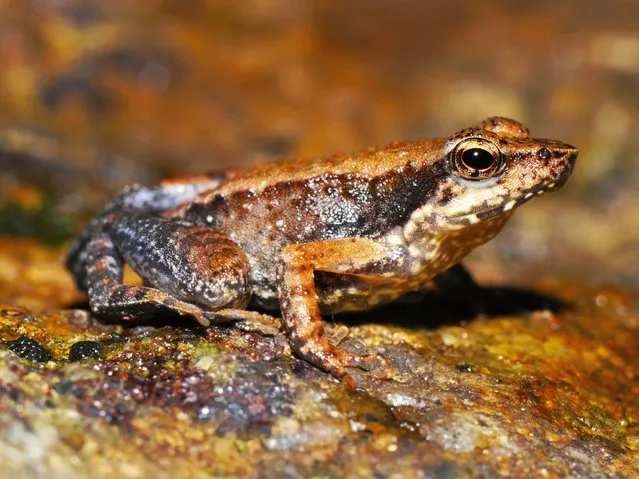
The study listing the new species brings the number of known Indian dancing frogs to 24 and attempts the first near-complete taxonomic sampling of the single-genus family found exclusively in southern India's lush mountain range called the Western Ghats, which stretches 1,600 kilometers (990 miles) from the west state of Maharashtra down to the country's southern tip. (Photo by Satyabhama Das Biju/AP Photo)
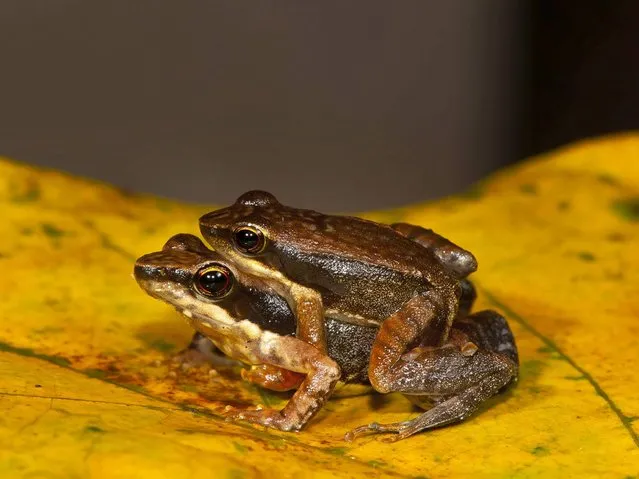
A frog couple from one of the 14 new species of so-called dancing frogs. (Photo by Satyabhama Das Biju/AP Photo)
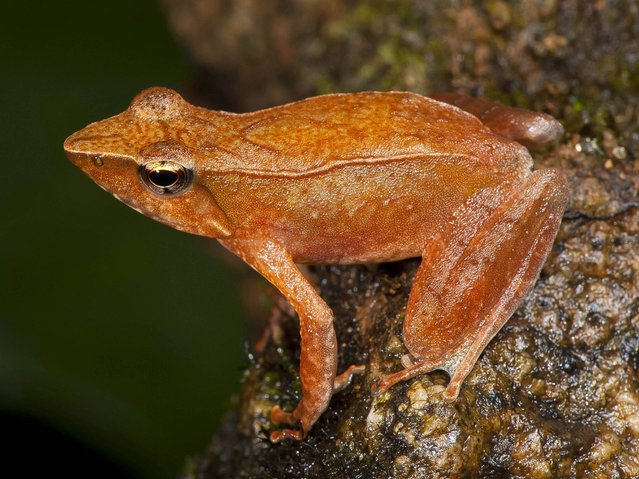
Orange dancing frog discovered by a team headed by University of Delhi professor Sathyabhama Das Biju in the jungle mountains of southern India. (Photo by Satyabhama Das Biju/AP Photo)
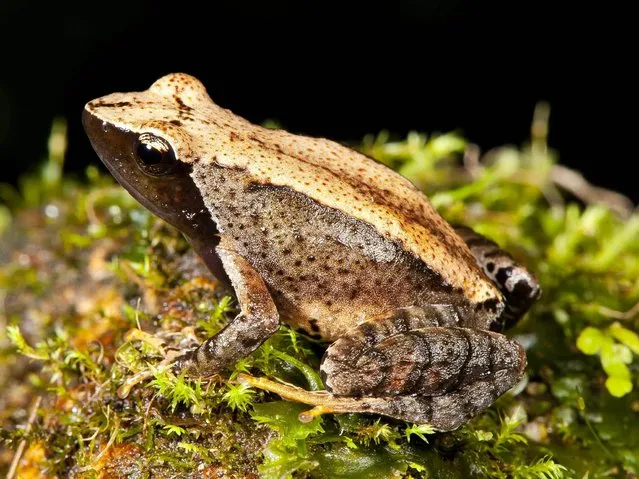
Dancing frogs earned their name with the unusual kicks they use to attract mates. (Photo by Satyabhama Das Biju/AP Photo)
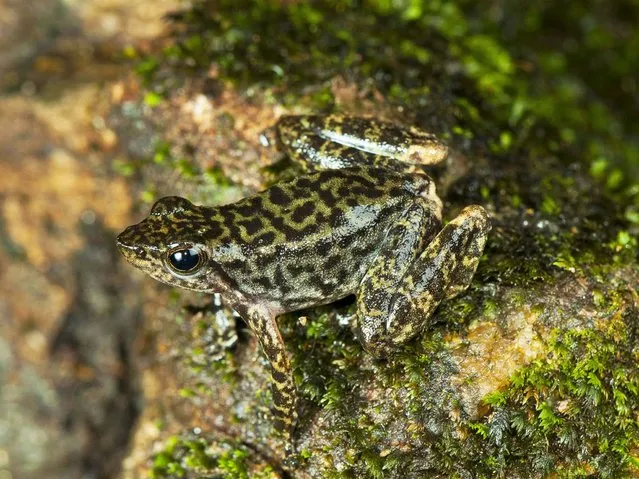
Biologists noticed dramatic decline in number of dancing frogs, during the 12 years in which they chronicled the species through morphological descriptions and molecular DNA markers. They breed after the yearly monsoon in fast-rushing streams, but their habitat appears to be becoming increasingly dry. (Photo by Satyabhama Das Biju/AP Photo)

Only the males dance it's actually a unique breeding behavior called foot-flagging. They stretch, extend and whip their legs out to the side to draw the attention of females who might have trouble hearing mating croaks over the sound of water flowing through perennial hill streams. (Photo by Satyabhama Das Biju/AP Photo)
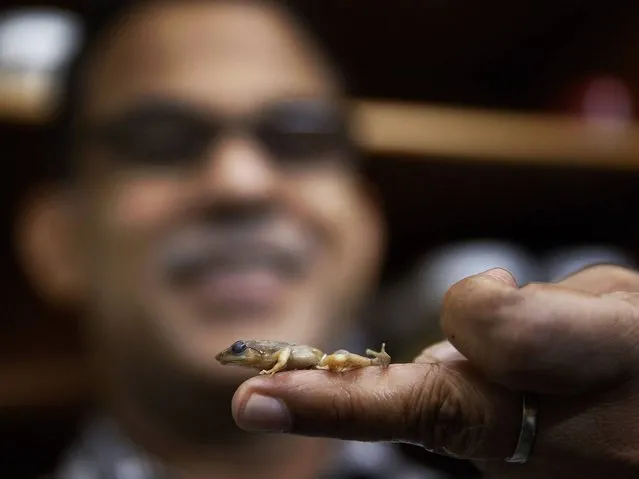
University of Delhi professor Sathyabhama Das Biju, lead scientist of a project that has discovered 14 new species of so-called dancing frogs in the jungle mountains of southern India, displays a dead specimen of one of the newly discovered species in his laboratory in New Delhi. (Photo by Satyabhama Das Biju/AP Photo)
09 May 2014 08:50:00,
post received
0 comments
